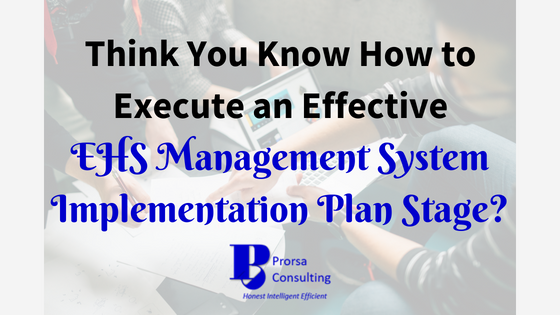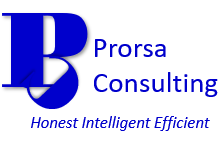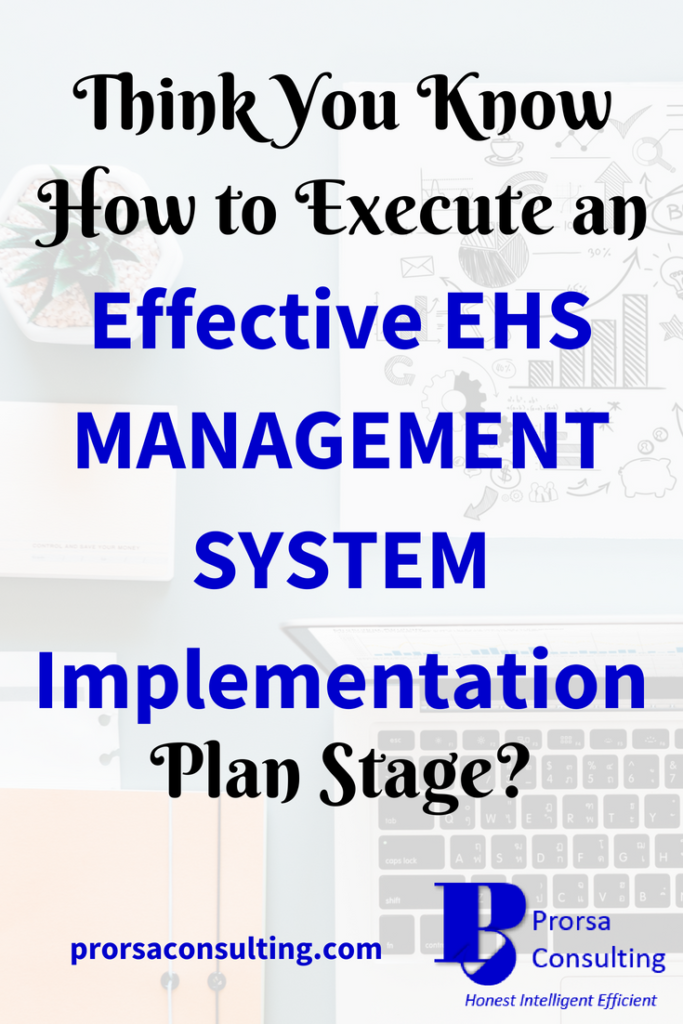Think You Know How to Execute an Effective EHS Management System Implementation Plan Stage?
By : Admin -

In our last post, Start Negotiating for EHS Management Systems Like the Pro You Are, we covered strategy to negotiate for an Environmental, Health, and Safety (EHS) Management System.
After you secure approval for an EHS management system implementation, the plan stage comes first in the Plan-Do-Check-Act (PDCA) Model.
As the foundation of the management system, the plan stage holds extreme importance for future success.
Practical EHS Management System Basics & Tips to Get You Out of the Gate outlined 10 activities for execution during the plan stage. In this post, we will discuss in detail these plan stage activities.
Note ISO 14001:2015 (Environmental Management) has been utilized as a guide for the listed plan stage activities. Nevertheless, the ISO 45001:2018 framework addressing Occupational Health and Safety Management largely aligns with the elements discussed here.
Gaining insight into the context of the organization
Can the organization undertake an EHS management system implementation with success?
What are the internal and external factors potentially impacting that success?
These questions form the basis for determining the organization’s current context.
Organizations should seek insight into their context in a holistic way.
For example, regulation, politics, operational constraints, geographic location, finances, stakeholders, etc. all play a part in the organization’s ability to affect its environmental and safety performance.
These items may create a positive or negative effect.
Determining the organization’s context provides the necessary information to appropriately scope the EHS management system.
Scoping the system
Armed with the information gleaned from assessing the context of the organization, you can readily set the scope for the EHS management system.
Scoping the system equates to drawing the boundary lines around the implementation.
All the locations, processes, functions, etc. indicated within the scope will fall under the purview of the management system.
As such, organizations should take great care in defining the scope of their systems.
Will the EHS management system implementation take place at the corporate, regional, functional, or facility level within the organization?
Which processes impacting EHS performance need inclusion?
Who are the stakeholders (employees, contractors, visitors, customers, suppliers, shareholders, etc.) to be affected by the EHS management system?
All of these questions must be addressed in the EHS management system scope.
Affirming the organization’s commitment to the management system
In addition, organizations must clearly declare their intentions with regards to EHS management systems.
ISO standards dictate organizations must commit to establishing, implementing, documenting, and continually improving their management systems.
Failure to meet any of these obligations would be detrimental to the system’s success.
As such, organizations should include language within their EHS manuals affirming their commitment to developing and maintaining their EHS management systems.
The commitment solidifies the common path forward for all parties affected.
Moreover, an upfront affirmation greenlights all the other activities associated with the EHS management system implementation.
Defining leadership & commitment
The organization’s top management has a special leadership role when it comes to an EHS management system.
Top management retains overall responsibility for the EHS management system’s success, just as it is assigned responsibility for overall business success.
As such, this group shows its commitment by actively participating, providing appropriate oversight, and promoting a co-operative spirit during the creation, implementation, and maintenance of the EHS management system.
Additionally, top management must ensure proper resources are and continue to be allocated for the EHS management system implementation and maintenance.
This includes the assignment/delegation of roles, responsibilities, and authorities and providing individuals with responsibilities under the management system access to any necessary training, time, tools, etc.
Providing financial resources for the development and upkeep of the system also falls under top management’s responsibilities.
Developing a policy statement
Another top management responsibility, one key to an EHS management system implementation, is the establishment of the organization’s policy statement(s) for EHS.
This statement basically outlines the organization’s specific EHS commitments and sets a framework for the business’s EHS objectives.
It should align with the business’s functions, scope, and overall vision.
To meet this particular requirement, organizations may choose to develop separate policies . . . one for environmental and one for health and safety.
Alternatively, one policy covering EHS may make the best sense.
EHS policies must be documented, communicated, periodically reviewed/updated, and made available to interested persons.
The ISO standards do prescribe minimum content requirements for EHS policies, including commitments to:
- Compliance with EHS legal & other requirements
- Pollution prevention
- Minimize/eliminate work-related illnesses & injuries
- Eliminate workplace hazards
- Worker participation & consultation
- Continuous improvement
Consult How to write an ISO 14001 Environmental Policy and How to write and OH&S Policy by Advisera for more information about developing an EHS policy suitable for your organization.
Assigning roles, responsibilities, and authorities
The duty of assigning & communicating roles, responsibilities, and authorities to individuals tasked with the EHS management system implementation and maintenance falls again to top management.
When making these assignments, top management must adequately delegation of responsibility for system conformance and ensure reporting of system performance to top management.
This responsibility usually falls to the system’s management representative.
When assigning roles & responsibilities, top management must also ensure those persons assigned duties under the management system have the appropriate authority to be effective in their assignments.
For instance, a group leader working to establish an operational procedure should have authority to direct the group’s activities.
If not given this authority, the leader will not have the ability to effectively attain the desired goal.
Organizations should outline the roles, responsibilities, and authorities of persons assigned specific tasks within the EHS management system implementation in the EHS manual.
Moreover, job descriptions & individual operational controls (i.e. standard operating procedures, environmental plans, etc.) also serve as ways to document expected responsibilities for affected individuals and groups.
Determining and assessing risks and opportunities
The process of determining and assessing risks and opportunities in the ISO 14001:2015 standard essentially replaces the concept of preventative actions under the ISO 14001:2004 standard.
The risk and opportunities component strives to address undesired effects and engender increased involvement from both leaders and employees in the process.
The ISO standard now expects an organization to document its risk and opportunities with associated actions and results.
These are identified in the site’s legal & other requirements, environmental aspects, health & safety hazards.
Additionally, the assessments should consider the organization’s context, stakeholders, and potential emergency situations.
Environmental Aspects
Businesses should evaluate with a lifecycle approach all environmental aspects of its current and planned activities, services, and products.
This means looking from cradle to grave, including all the events occurring between the two.
The ISO standard mandates documenting environmental aspects, their related impacts, and the process utilized to determine these.
Significant environmental impacts must also include a determination and documentation to meet the standard’s requirements.
Health & Safety Hazards
Health & safety hazards must undergo an assessment with the same thoroughness as the environmental aspects.
During this evaluation, consider the hazards encountered due to the workplace environment, operational processes, and specific work tasks.
Recognized risks need to have proper controls identified to eliminate or mitigate the hazards.
As with environmental aspects, the hazards, risks, controls, and the process utilized to evaluate these must have documentation.
Legal and Other Requirements
Legal and other requirements also may present potential EHS risk.
Identifying and assessing compliance obligations are an integral part of an EHS management system implementation.
This portion of the plan stage activity gives the organization the opportunity to perform a full EHS regulatory applicability determination.
Additionally, the legal & other requirements exercise provides an opportunity to identify other requirements, such as the ISO requirements or business requirements related to EHS.
This information helps to drive future activities undertaken during the Do, Check, and Act stages of the EHS management system implementation.
ISO standards mandate documentation of EHS legal and other requirements within the management system.
Action Planning
Moreover, an organization must plan its actions with regards to its risks and opportunities, environmental aspects, health & safety hazards, and legal & other requirements.
This planning sets the foundation for a sizeable portion of the necessary operational controls and monitoring/measurement activities associated with the EHS management system.
Moreover, setting objectives and targets for significant environmental aspects and health & safety performance is also expected.
Objectives and targets should be SMART . . . specific, measurable, achievable, relevant, and timely.
As such, organizations should consider alignment with EHS policy and financial, operational, and technological feasibility when planning its actions, objectives, and targets.
Documenting, communicating, monitoring, and updating objectives and targets are a requirement of ISO and are essential to attaining the desired results.
Defining and distributing resources
When looking at the resources needed for an EHS management system, one needs to evaluate both near- and long-term obligations.
It is not enough to simply provide resources for the initial EHS management system implementation. The ISO standards mandate maintenance and ongoing improvement of the system.
Without proper resources, the system will fail to thrive.
Moreover, resources go beyond simple finances.
They include people, tools, equipment, training, etc. . . . basically, you should label anything necessary for the initial development or ongoing sustainability of the system as a resource.
This does not mean the EHS management system operates with a blank check.
Therefore, sound evaluation and decision-making, keeping in mind the business scope and desired outcomes, makes the most sense when considering resources for the system.
Making sure the allocated resources find their way to the people, areas, and activities where they are needed is crucial for system success.
It does not make for good business to allocate money to fix a problem that does not exist.
Providing training to workers who won’t use it in their job duties also would not demonstrate resource stewardship.
These resources would provide a greater benefit elsewhere.
As an EHS management system matures, one would anticipate priorities to shift and the resources to follow.
Thus, in defining and distributing resources, periodic evaluations and updates are paramount to system performance.
Establishing strategies to facilitate adequate competence, awareness, and communication
Almost everyone is familiar with the meaning of the phrase “Scientia potentia est” even though most may not be aware they know it.
“Scientia potential est” is Latin for “knowledge is power” [https://en.wikipedia.org/w/index.php?title=Scientia_potentia_est&oldid=830670464].
An EHS management system’s power comes from the people making the system function.
Without proper competence, awareness, and communication, individuals lack the knowledge needed to power a successful system.
Any EHS management system implementation must address how the organization will appropriately train, promote awareness, consult with workers, and promote participation within the system.
This will not be a one size fits all for every employee.
Some workers will need specialized system training, while others may not.
A manager may choose to participate in some areas of the system while other workers elect different avenues for participation.
Determining and the who, what, and when associated with training, awareness promotion, consultation, and participation is the key to accomplishing this plan stage activity.
The ISO standards set expectations for both internal and external communications associated with a management system.
In general, communications should be relevant, appropriate, and ongoing.
ISO does not prescribe specific communication frequencies.
Organizations should communicate on EHS at time intervals adequate enough to keep the system functioning properly and promote continuous improvement.
As with most other EHS management system elements, evidence must exist to show a process is in place and being implemented with regards to competence, awareness, communication [and consultation & participation for ISO 45001].
Thus, the EHS manual should speak to these particular portions of the system.
In addition, it is customary to have an operational control (i.e. a procedure) covering how these activities will be conducted.
Training, communication, and participation records should also be kept as evidence of implementation.
Creating a framework to manage documented information
Throughout this post, we have stressed the need for documentation on several occasions.
An EHS management system has two main types of documented information . . . documents and records.
Businesses internally established documents and records or have them issued by an external party.
Documents consist of written items which receive an update on a periodic basis, such as compliance plans, standard operating procedures, safety data sheets, permits, etc.
On the other hand, organizations produce records usually as evidence an activity took place.
Thus, records do not change. These would include things like training records, inspection reports, monitoring results, etc.
Regardless of the type of documented information being addressed, the plan stage of an EHS management system implementation must outline a framework to ensure this information is controlled, accessible to those requiring the information, and updated as needed.
Therefore, organizations must establish a written process for the management of documented information.
The process should have a mechanism for identifying which documents and records fall under the EHS management system.
Additionally, key data concerning the documents and records, such as revision dates, document/record locations, responsible persons, retention requirements, etc., must be tracked.
This helps ensure the documented information management process operates as designed.
Organizations may choose to manage documented information in hardcopy format, an electronic system, or a hybrid of these.
Paper-based information management can cause administrative challenges. Yet, it has low overhead costs and can be easily accessible to all persons.
An electronic system may be costly and require additional training to implement. However, it has the ability to reduce the effort associated with tracking documented information data.
Electronic systems also save paper and physical space.
There are pros and cons to any documented information management strategy.
So, organizations should choose the best solution given their resources, while meeting obligations under the ISO standards.
Related EHS Management System Planning Articles You May Find Useful
How to Craft an Informative EHS Awareness Program for Continued, High-Value Business Wins
Final Thoughts
The plan stage of any EHS management system implementation can seem like a daunting task.
Nevertheless, thoughtful planning leads to a management system foundation to use for building future success.
With the 10 plan stage activities outlined in this post, you will be well on your way to an EHS management system that produces excellent outcomes.
Prorsa Consulting is available to assist with your EHS compliance, training, data analysis, and management system needs. Check out the Services page for more information. You can also contact us via contact@prorsaconsulting.com with any questions about our services.
We encourage your feedback on this blog’s content. If you found this information useful, be sure to like and/or share below. You can also give your feedback via our Contact Us page.
Don’t forget to sign up for the Prorsa Consulting Newsletter to receive exclusive content and blog updates. Moreover, you can follow Prorsa Consulting on Google+, LinkedIn, Pinterest, and Twitter.

